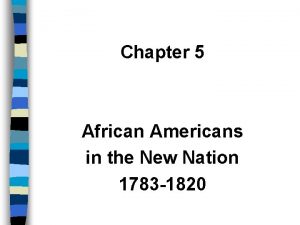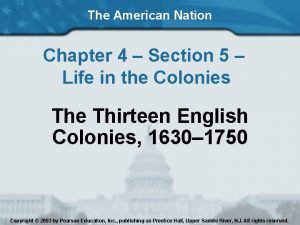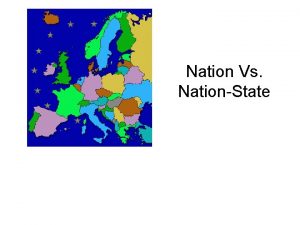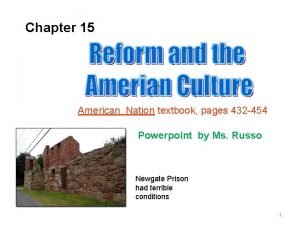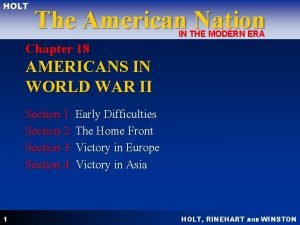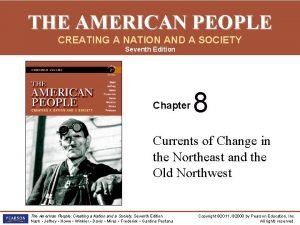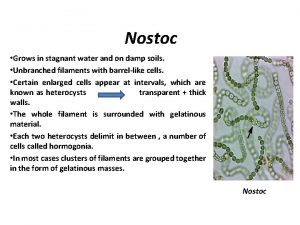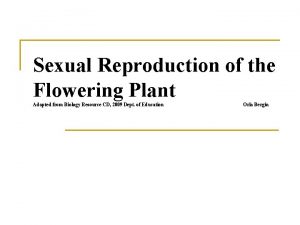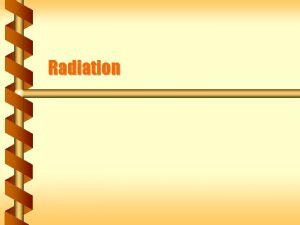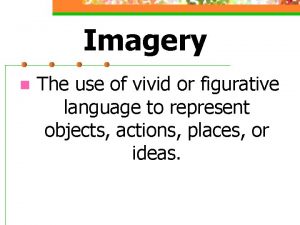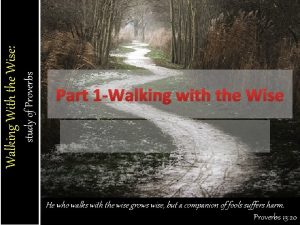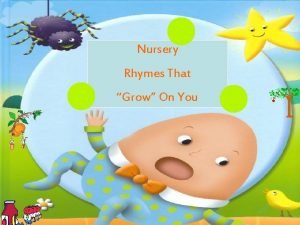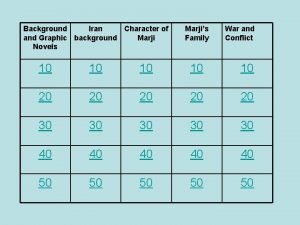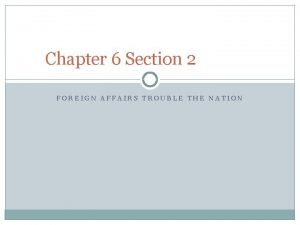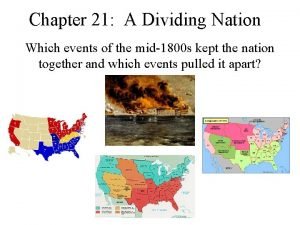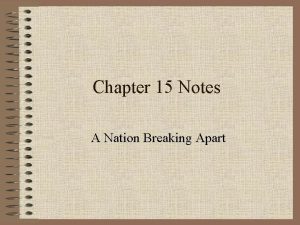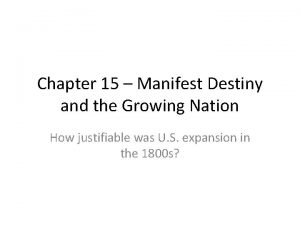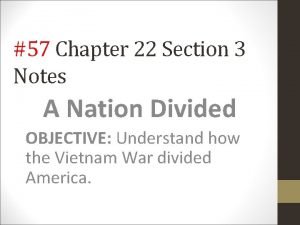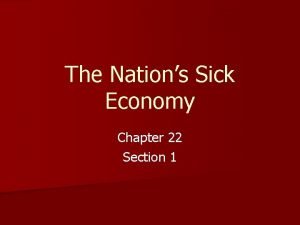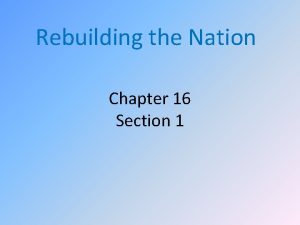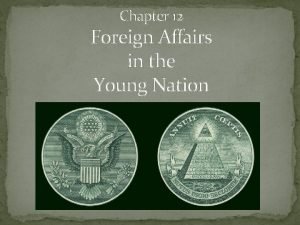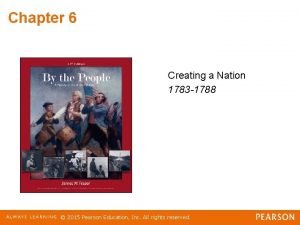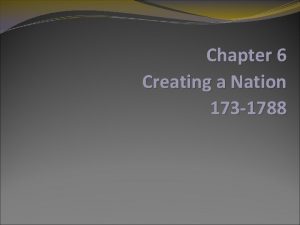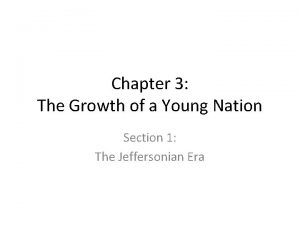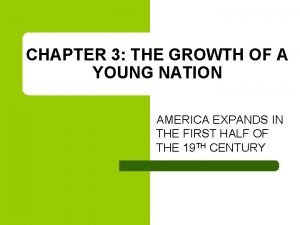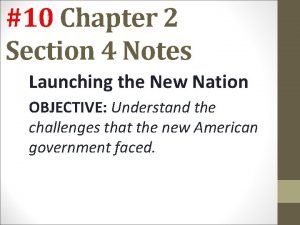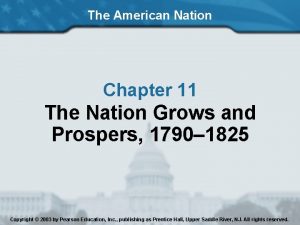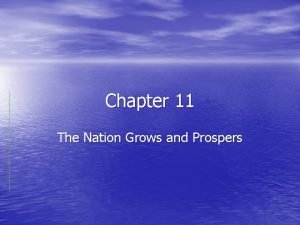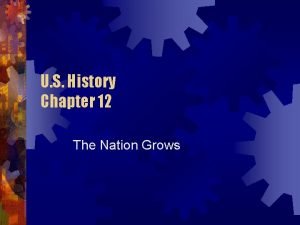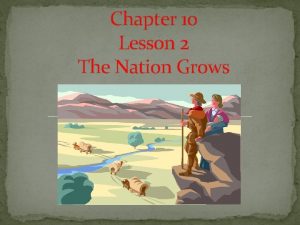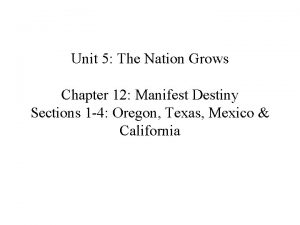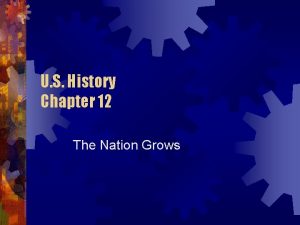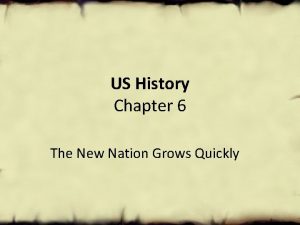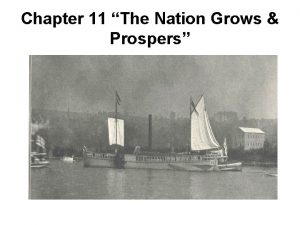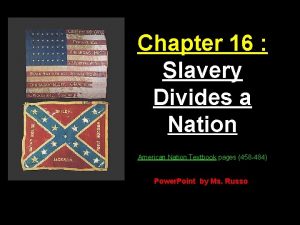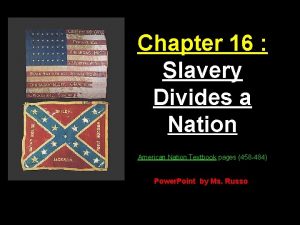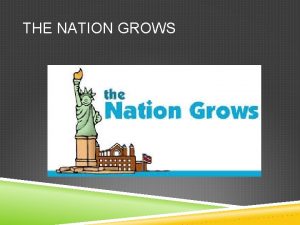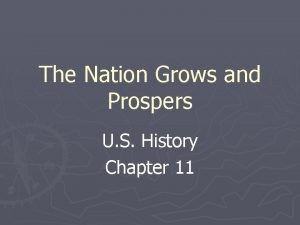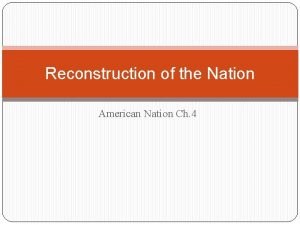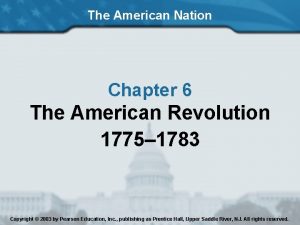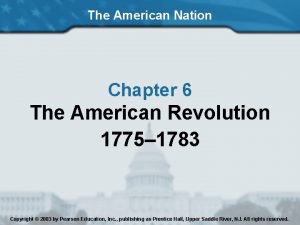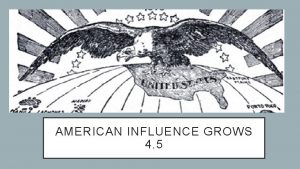The American Nation Chapter 11 The Nation Grows












































































- Slides: 76

The American Nation Chapter 11 The Nation Grows and Prospers, 1790– 1825 Copyright © 2003 by Pearson Education, Inc. , publishing as Prentice Hall, Upper Saddle River, NJ. All rights reserved.

The American Nation Chapter 11: The Nation Grows and Prospers, 1790– 1825 Section 1: The Industrial Revolution Section 2: Americans Move Westward Section 3: Unity and Division Section 4: New Nations in the Americas Copyright © 2003 by Pearson Education, Inc. , publishing as Prentice Hall, Upper Saddle River, NJ. All rights reserved.

The Industrial Revolution Chapter 11, Section 1 • What was the Industrial Revolution, and how did it take hold in the United States? • Why was Lowell, Massachusetts, called a model factory town? • What was daily life like in early factories? • What impact did the Industrial Revolution have on American cities?

The Industrial Revolution Chapter 11, Section 1 Industrial Revolution—a long, slow process, begun in Britain, that completely changed the way goods were produced • Gradually machines replaced hand tools. • New sources of power- steam replaced human & animal power. • Economy began a gradual shift toward manufacturing.

• New technology transformed the textile industry. • the spinning jenny, invented by James Hargreaves, could spin several threads at once, replaced the spinning wheel, which spun one thread at a time. • A water-powered loom, invented by Edmund Cartwright, that could weave cloth faster replaced older, hand-operated looms.

• Instead of working alone in their homes, many workers went to work where the machinery was—in large mills near rivers. This new system of work is called the factory system.

• Large amounts of capital, or money, were needed to set up and operate large mills. Capitalists—people who invest in a business in order to make a profit—supplied the money

How the Industrial Revolution Came to the United States Chapter 11, Section 1 The First American Mill • Samuel Slater, a skilled mechanic in a British textile mill, heard that Americans were offering rewards for British factory plans. • Slater memorized the design of machines in the mill and took them to New York • In Pawtucket, Rhode Island, he built the first successful textile mill in the U. S. powered by water.

Interchangeable Parts • In the past, workers made goods by hand. Each item was slightly different than every other item. • Because of that, you could not take the parts of one item and put them on the another.

Interchangeable Parts • Eli Whitney had the idea of having machines manufacture each part. All parts would be alike, or interchangeable. Interchangeable parts would save time and money. He showed his idea with muskets, but the idea of interchangeable parts also applied to many other goods.

Lowell, Massachusetts: A Model Factory Town Chapter 11, Section 1 • In Britain, one factory spun thread another wove it into cloth. Francis Lowell had the idea of combining spinning and weaving under one roof. • After Lowell’s death, his partners built an entire factory town, with streets of small, neat, white houses.

• The company hired young women from nearby farms. They came to be called the Lowell girls. The company built boardinghouses for them and made rules to protect them.

Daily Life During the Industrial Revolution • Child Labor- Boys and girls as young as seven worked in factories. Often, their wages were needed to help support their family. • Long Hours - long— 12 hours a day, 6 days a week year round.

Daily Life During the Industrial Revolution • Changes in home life- many family members left the home to earn a living. In poorer families, women often had to go out to work, but in middleclass families, women usually stayed home.

Cities begin to grow • Many people left farms to go live and work in cities, where factories were. (urbanization) • Cities sprang up around factories.

Section 1 Assessment Chapter 11, Section 1 The Industrial Revolution gradually changed the way people worked. After the Industrial Revolution, a) more people were able to work at home. b) more skilled workers were British. c) many workers produced goods in one place with machinery. d) workers doing different tasks usually worked in separate buildings. Want to connect to the American History link for this section? Click here.

The Industrial Revolution had an impact on family life because a) workers now left their homes to earn a living. b) women stayed home to do the farming while men went to work in factories. c) factory workers worked shorter hours than farmers. d) factories would not hire anyone younger than 18.

Section 1 Assessment Chapter 11, Section 1 The Industrial Revolution gradually changed the way people worked. After the Industrial Revolution, a) more people were able to work at home. b) more skilled workers were British. c) many workers produced goods in one place with machinery. d) workers doing different tasks usually worked in separate buildings. The Industrial Revolution had an impact on family life because a) workers now left their homes to earn a living. b) women stayed home to do the farming while men went to work in factories. c) factory workers worked shorter hours than farmers. d) factories would not hire anyone younger than 18. Want to connect to the American History link for this section? Click here.

Americans Move Westward Chapter 11, Section 2 • How did settlers travel west in the early 1800 s? • What steps did Americans take to improve their roads? • How did steamboats and canals improve transportation for Americans?

Steamboats Revolutionize the economy • The steam engine revolutionized the economy of farmers and merchants because it gave them a cheap means of moving goods. • Because some rivers were shallow, Henry Shreve designed a flat-bottomed steamboat. This boat could carry heavy loads without getting stuck on sandbars

Improving American Roads Turnpikes • Private companies built gravel and stone roads. • They collected tolls from travelers. • At points along the road, a pike, or pole, blocked the road. After the wagon driver paid a toll, the pike keeper turned the pole aside.

Improving American Roads Corduroy roads • Roads made of logs. • Looked like corduroy cloth. • Made a very noisy and bumpy ride.

Improving American Roads The National Road • Ran from Cumberland, Maryland, to Wheeling, in western Virginia. • The 1 st time Congress approved funds for a national road-building project.

Improving American Roads • The best road in the U. S. was the Lancaster Turnpike, linking Philadelphia and Lancaster, Pennsylvania.

Development of the Steamboat John Fitch showed how a steam engine could power a boat. He opened a ferry service on the Delaware River, but few people used it, and he went out of business.

Chapter 11, Section 2 Steamboats Improved Transportation • Robert Fulton launched his own steamboat, the Clermont. • His success began the steamboat era. • Steamboats began to carry passengers along the Atlantic coast. • Carried passengers and goods on the Mississippi, Ohio, and Missouri rivers.

Steamboats could be dangerous • July 28, 1855 - captain of Henry Clay navigated down the Hudson River; spotted the Armenia; ordered his crew to stoke the boiler. • The Henry Clay caught on fire; passengers scrambled for their lives • 90 people had drowned or burned to death • Steamboats were able to go upstream rather than just downstream.

Steamboats could be dangerous • Henry Shreve designed a flatbottomed steamboat for shallow western rivers. • Steamboats could be dangerous as high pressure boilers sometimes exploded • In a 40 year period 44 collided, 166 burned & more than 200 exploded

Canals Improved Transportation Chapter 11, Section 2 The Erie Canal • Some New Yorkers had the idea of building a *canal linking the Great Lakes with the Mohawk and Hudson rivers. • The Erie Canal would let western farmers ship their goods to New York. • New York governor De. Witt Clinton persuaded the state legislature to put up money for the Erie Canal.

The Erie Canal • Work began in 1817 and was finished in 1825. • Success! *The cost of shipping goods dropped to about one tenth of what it had been & helped make New York City a commercial center. • Success of the Erie Canal led other states to build canals, too.

Canals Improved Transportation Chapter 11, Section 2

Section 2 Assessment Chapter 11, Section 2 The first time Congress ever put up funds for a national transportation project, the money was for the a) Erie Canal. b) Wilderness Road. c) Corduroy Road. d) National Road. Want to connect to the American History link for this section? Click here.

Supporters argued that the Erie Canal would a) provide a route around waterfalls on the Hudson River. b) let western farmers ship their goods to the port of New York. c) connect the Great Lakes for travel from one lake to another. d) eliminate sandbars.

Section 2 Assessment Chapter 11, Section 2 The first time Congress ever put up funds for a national transportation project, the money was for the a) Erie Canal. b) Wilderness Road. c) Corduroy Road. d) National Road. Supporters argued that the Erie Canal would a) provide a route around waterfalls on the Hudson River. b) let western farmers ship their goods to the port of New York. c) connect the Great Lakes for travel from one lake to another. d) eliminate sandbars. Want to connect to the American History link for this section? Click here.

Unity and Division Chapter 11, Section 3 • What role did sectionalism play in the nation during the Era of Good Feelings? • How did Congress help American industry after the War of 1812? • What was Henry Clay’s American System? • How did the Supreme Court give more power to the Federal government?

The Era of Good Feelings Chapter 11, Section 3 James Monroe • A Republican; defeated the Federalist candidate for President in the election of 1816. • A popular, easygoing President, he hoped to create a new sense of national unity.

The Era of Good Feelings James Monroe contd. • One newspaper wrote that the United States was entering an “era of good feelings. ” • Most members of the Federalist party had left the party. Many Federalists joined the Republican Party. • The republicans re-established the sense of national unity. • When he ran for a second term, no candidate opposed him. • Sectionalism effected the “Era of good feeling” because it showed loyalty to ones state or section rather than to the nation.

Rise of Sectional Interests Disputes between different sections of nation grew. • John C. Calhoun—the South • Daniel Webster—the North • Henry Clay—the West

Rise of Sectional Interests Chapter 11, Section 3 Voices for Different Sections of the Country John C. Calhoun—the South • Supported the War of 1812 • Defended slavery • Opposed strengthening the power of the federal government

Rise of Sectional Interests Daniel Webster—the North • Opposed the War of 1812 and refused to vote for taxes to pay for the war. • Wanted the federal government to take a larger role in building the nation’s economy • Opposed slavery.

Rise of Sectional Interests Henry Clay—the West • A War Hawk who promoted the War of 1812 • Favored a more active role for the federal government in promoting the country’s growth

Solving Economic Problems Problem: The charter of the first Bank of the United States ran out. Individual states issued money. They put too much money in circulation. Prices rose. Solution: Congress chartered a second Bank of the United States. What the bank did: The bank lent money and regulated the nation’s money supply.

Solving Economic Problems Problem: • After the War of 1812, American businesses faced British competition. • Because the British had a head start in industrializing, they had already paid off the cost of starting their factories, so they could make & sell goods more cheaply than Americans.

Solving Economic Problems Problem contd: • The British planned to put US factories out of business by selling their goods much cheaper than US goods. • Then, raise prices.

Solving Economic Problems Solution: A protective tariff—the Tariff of 1816 What it did: The Tariff of 1816 greatly raised tariffs on imports. • This made imported goods more expensive than American-made goods.

The Tariff of 1816 Chapter 11, Section 3

Henry Clay’s American System Chapter 11, Section 3 A problem • Sectionalism—loyalty to one’s state or section rather than to the nation as a whole. Clashes over the tariff were an example of sectionalism. Henry Clay’s plan • With his American System, Henry Clay wanted to promote economic growth for all sections.

Henry Clay’s American System • High tariffs on imports would help northern factories. • Northerners could then buy farm products from the West and the South. • Use the money from tariffs for internal improvements—build roads, bridges, & canals. • Improved transportation would help western & southern farmers ship goods to market.

Henry Clay’s American System The opposition • Southerners already had many rivers so they opposed paying for roads and canals. • Unintended Results: Sectionalism grew in the U. S. *** • Made national unity more difficult. ***

Supreme Court Expands Federal Power Mc. Culloch v. Maryland (1819) The Issue: Maryland tried to tax the Bank of the United States. The Bank cashier refused to pay. The Decision: The Court ruled that states had no right to interfere with federal institutions within their borders.

Supreme Court Expands Federal Power Gibbons v. Ogden (1824) The Issue: A New York law tried to control steamboat travel between New York and New Jersey.

Gibbons v. Ogden (1824) • The Decision: The Court ruled that a state could regulate trade only within its borders, but only the federal government had the power to regulate interstate commerce, or trade between different states.

Section 3 Assessment Chapter 11, Section 3 During the Era of Good Feelings, sectionalism began to grow. Sectionalism is a) favoring raising tariffs in one section but not in the others. b) loyalty to one’s state or section over loyalty to the nation as a whole. c) protecting a country’s industries from foreign competition. d) having different money in different sections of the country. Want to connect to the American History link for this section? Click here.

The expression “internal improvements” refers to a) gaining wealth from industry within a state. b) taxing federal institutions within a state. c) increased trade within the borders of one state. d) improvements in roads, bridges, and canals.

Section 3 Assessment Chapter 11, Section 3 During the Era of Good Feelings, sectionalism began to grow. Sectionalism is a) favoring raising tariffs in one section but not in the others. b) loyalty to one’s state or section over loyalty to the nation as a whole. c) protecting a country’s industries from foreign competition. d) having different money in different sections of the country. The expression “internal improvements” refers to a) gaining wealth from industry within a state. b) taxing federal institutions within a state. c) increased trade within the borders of one state. d) improvements in roads, bridges, and canals. Want to connect to the American History link for this section? Click here.

New Nations in the Americas Chapter 11, Section 4 • How did the Latin American nations win independence and become republics? • How did the United States gain Florida from Spain? • What was the purpose of the Monroe Doctrine?

Latin American Nations Win Independence • Mexico • Father Hidalgo and Father Morelos led peasant movements for independence from Spain. Both were captured and executed by the Spanish. • Creoles—people born in Latin America to Spanish parents—joined the revolutionary movement. In 1821, revolutionary forces won control of Mexico.

Latin American Nations Win Independence • Republic of Great Colombia • In 1819, Simon Bolívar led an army from Venezuela into Colombia and defeated Spanish forces there. He became president of the Republic of Great Colombia. • Bolivar became known as “The Liberator” for leading the independence movement.

Latin American Nations Win Independence Chapter 11, Section 4

The United States Gains Florida Chapter 11, Section 4 Many Americans wanted Florida. • Southerners worried about the Creek and Seminole Indians of Florida raiding Georgia settlements. • Many slaves escaped to Florida. About 1, 000 runaway slaves lived in settlement on the Apalachicola River known as Negro Fort.

The United States Gains Florida • In 1818 Andrew Jackson led American troops into Florida. Spain protested but was busy with revolutions in Latin America. • In the Adams-Onís Treaty, Spain agreed to give Florida to the U. S. for $5 million.

The Monroe Doctrine Chapter 11, Section 4 The Background • In 1815, Prussia, France, Russia, and Austria formed an alliance aimed at crushing any revolution in Europe. They seemed ready to help Spain take back its colonies in Latin America. • Russia claimed lands on the Pacific coast of North America.

Latin American Nations Win Independence Chapter 11, Section 4

The Monroe Doctrine • The British feared their trade would be hurt if Spain regained control of its former colonies. • So, Britain suggested the U. S. and Britain issue a joint statement guaranteeing the freedom of the new nations.

The Monroe Doctrine Chapter 11, Section 4 Monroe’s Foreign Policy • President Monroe acted independently of Britain. He issued a foreign policy statement known as the Monroe Doctrine. • Britain supported Monroe’s statement

The Monroe Doctrine said…. . • The U. S. would not interfere in the affairs of European nations or their existing colonies. • At the same time, European nations should not try to regain control of the newly independent nations of Latin America.

The Monroe Doctrine said…. . • The U. S. would oppose any attempt to build new colonies in the Americas. • Several Presidents have called on the Monroe Doctrine to challenge European intervention, or direct involvement, in Latin America.

Short Version of Monroe Doctrine • To protect new South American nations from European attack. • To keep European powers out of the Western Hemisphere. • To keep European powers from reclaiming newly independent South American nations as colonies.

Section 4 Assessment Chapter 11, Section 4 One reason the United States wanted Florida was that a) New England merchants wanted to trade there. b) southerners wanted to keep enslaved African Americans from escaping to Florida. c) American hunters wanted the opportunity to trap alligators. d) Father Hidalgo had called for freedom. Want to connect to the American History link for this section? Click here.

The Monroe Doctrine states that a) European nations should not build new colonies in the Americas. b) Spain should sell Florida to the United States for a reasonable price. c) wealthy creoles should give up land to peasants. d) American trade should favor the British.

Section 4 Assessment Chapter 11, Section 4 One reason the United States wanted Florida was that a) New England merchants wanted to trade there. b) southerners wanted to keep enslaved African Americans from escaping to Florida. c) American hunters wanted the opportunity to trap alligators. d) Father Hidalgo had called for freedom. The Monroe Doctrine states that a) European nations should not build new colonies in the Americas. b) Spain should sell Florida to the United States for a reasonable price. c) wealthy creoles should give up land to peasants. d) American trade should favor the British. Want to connect to the American History link for this section? Click here.

The Missouri Compromise Chapter 16, Section 1 • In 1819, there were 11 free states and 11 slave states. • Representation in the Senate was evenly balanced between the North and the South. • Missouri wanted to join the Union as a slave state. That would give the South a majority in the Senate.

The Missouri Compromise Henry Clay proposed the Missouri Compromise. • Missouri would join the Union as a slave state. • Maine would join the Union as a free state.

The Missouri Compromise • Congress drew an imaginary line across the southern border of Missouri at latitude 36º 30´N. • Slavery would be permitted in the Louisiana Purchase south of that line. • Slavery would be banned north of that line except in Missouri • hey


 Lesson 5 american influence grows
Lesson 5 american influence grows Chapter 5 african american in the new nation
Chapter 5 african american in the new nation American nation chapter 4
American nation chapter 4 American nation chapter 4
American nation chapter 4 Where the red fern grows chapter 10
Where the red fern grows chapter 10 Country vs nation
Country vs nation Nation state vs nation
Nation state vs nation Nation state vs nation
Nation state vs nation The american nation textbook answers
The american nation textbook answers Holt american nation
Holt american nation The american people creating a nation and a society
The american people creating a nation and a society Where the red fern grows vocabulary words and page numbers
Where the red fern grows vocabulary words and page numbers Old dan and little ann's grave
Old dan and little ann's grave Where the red fern grows questions
Where the red fern grows questions Where the red fern grows summary
Where the red fern grows summary Characteristics of assembly language
Characteristics of assembly language Love versus in love
Love versus in love Image land art
Image land art Stack grows downwards
Stack grows downwards During interphase a cell grows duplicates organelles and
During interphase a cell grows duplicates organelles and Cinderella went upstairs to kiss her fella
Cinderella went upstairs to kiss her fella Grows model
Grows model Centriole
Centriole What grows in stagnant water
What grows in stagnant water Hair grows in diagonal tubes called hair
Hair grows in diagonal tubes called hair Where the red fern grows vocabulary
Where the red fern grows vocabulary Facts about wilson rawls
Facts about wilson rawls Bean seed
Bean seed Hot metal contracts as it grows cooler
Hot metal contracts as it grows cooler The use of vivid or figurative language
The use of vivid or figurative language He who walks with the wise grows wise
He who walks with the wise grows wise Farmers nursery rhymes
Farmers nursery rhymes Marji character traits
Marji character traits Abolitionist sentiment grows
Abolitionist sentiment grows Foreign affairs chapter 6
Foreign affairs chapter 6 Fast food chapter 15
Fast food chapter 15 How did the raid on lawrence kansas pull the nation apart
How did the raid on lawrence kansas pull the nation apart Chapter 15 the nation breaking apart
Chapter 15 the nation breaking apart Chapter 15 manifest destiny and the growing nation
Chapter 15 manifest destiny and the growing nation Chapter 22 section 3 a nation divided
Chapter 22 section 3 a nation divided Chapter 22 section 1 the nation's sick economy
Chapter 22 section 1 the nation's sick economy Chapter 16 section 1 rebuilding the nation answer key
Chapter 16 section 1 rebuilding the nation answer key Lesson 12 foreign affairs in the young nation
Lesson 12 foreign affairs in the young nation Chapter 10 section 1 building a german nation
Chapter 10 section 1 building a german nation Chapter 6 creating a nation
Chapter 6 creating a nation Chapter 6 creating a nation
Chapter 6 creating a nation Chapter 3 the growth of a young nation
Chapter 3 the growth of a young nation Chapter 3 the growth of a young nation
Chapter 3 the growth of a young nation Chapter 2 section 4 launching the new nation
Chapter 2 section 4 launching the new nation Hát kết hợp bộ gõ cơ thể
Hát kết hợp bộ gõ cơ thể Bổ thể
Bổ thể Tỉ lệ cơ thể trẻ em
Tỉ lệ cơ thể trẻ em Chó sói
Chó sói Thang điểm glasgow
Thang điểm glasgow Chúa yêu trần thế
Chúa yêu trần thế Kể tên các môn thể thao
Kể tên các môn thể thao Thế nào là hệ số cao nhất
Thế nào là hệ số cao nhất Các châu lục và đại dương trên thế giới
Các châu lục và đại dương trên thế giới Công thức tiính động năng
Công thức tiính động năng Trời xanh đây là của chúng ta thể thơ
Trời xanh đây là của chúng ta thể thơ Mật thư anh em như thể tay chân
Mật thư anh em như thể tay chân Làm thế nào để 102-1=99
Làm thế nào để 102-1=99 độ dài liên kết
độ dài liên kết Các châu lục và đại dương trên thế giới
Các châu lục và đại dương trên thế giới Thơ thất ngôn tứ tuyệt đường luật
Thơ thất ngôn tứ tuyệt đường luật Quá trình desamine hóa có thể tạo ra
Quá trình desamine hóa có thể tạo ra Một số thể thơ truyền thống
Một số thể thơ truyền thống Cái miệng bé xinh thế chỉ nói điều hay thôi
Cái miệng bé xinh thế chỉ nói điều hay thôi Vẽ hình chiếu vuông góc của vật thể sau
Vẽ hình chiếu vuông góc của vật thể sau Nguyên nhân của sự mỏi cơ sinh 8
Nguyên nhân của sự mỏi cơ sinh 8 đặc điểm cơ thể của người tối cổ
đặc điểm cơ thể của người tối cổ Thế nào là giọng cùng tên
Thế nào là giọng cùng tên Vẽ hình chiếu đứng bằng cạnh của vật thể
Vẽ hình chiếu đứng bằng cạnh của vật thể Tia chieu sa te
Tia chieu sa te Thẻ vin
Thẻ vin đại từ thay thế
đại từ thay thế

